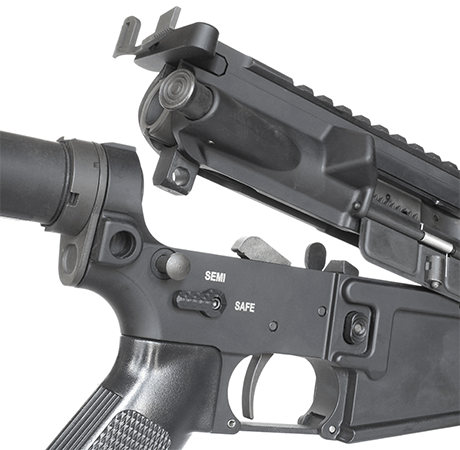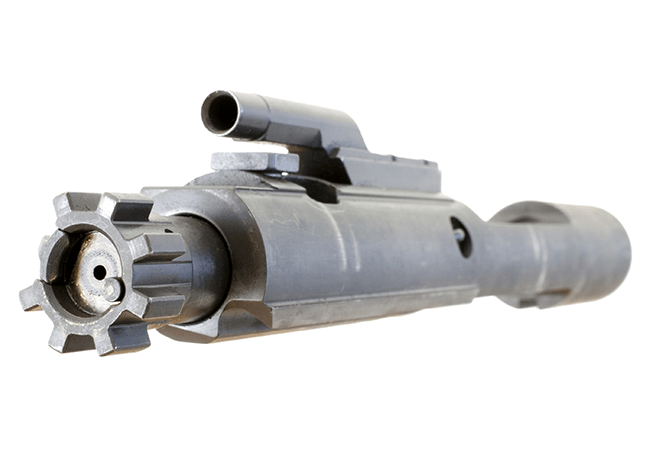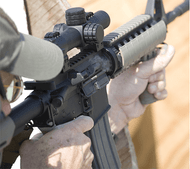How To Clean & Lubricate an AR
Owning an AR-platform rifle comes with the responsibility of regular maintenance. Even the most reliable firearms, including ARs, are not immune to malfunctions. Occasional jams are normal, but frequent issues often require proper care. Regular cleaning and lubrication are essential to keep your AR—whether it’s an AR-15, AR-10, carbine, or rifle—functioning smoothly and reliably.
Our guide walks you through the steps on how to clean an AR-15, from field-stripping to thorough maintenance, ensuring your rifle stays in top working condition.
How Often Does Your AR Need Maintenance?
Ask shooters at the range how often you should clean a rifle like the AR-15, and you’ll get nearly as many answers. You might hear recommendations such as every 300, 500, or 1,000 rounds, every month, every two months, or even after every visit to the range.
The only definitive answer is that it depends. First, ask yourself a simple question: How often do you shoot your AR? Do you only take it out once a month, go shooting every weekend, or are you a hardcore enthusiast with hundreds of rounds per week?
Occasional Shooters
If you shoot only occasionally, you can clean and lubricate your AR after every range trip. This will prevent carbon and other deposits from remaining inside your firearm for extended periods and wearing out its components.
Frequent Shooters
Inspect your AR regularly for signs of carbon deposits inside the barrel and chamber at the end of your shooting session. Check the number of rounds you fired since the last time you gave it a full cleaning instead of just re-lubricating it.
Continue until your rifle starts experiencing malfunctions more often than usual, then clean it thoroughly. Note the round count at that point; this is how frequently you should clean it. For example, if your rifle withstands about 3,000 rounds before experiencing malfunctions due to fouling, your cleaning schedule is once every 3,000 rounds.
Depending on the quality of your rifle and ammunition, your AR can last anywhere between a few thousand rounds to well over 10,000 before it needs a proper cleaning.
Stripping and Preparing Your AR For Maintenance
Partial disassembly is the first step of any maintenance task with an AR-platform rifle. You only need to strip as far as necessary to clean or lubricate the relevant parts. The military refers to this process as field-stripping because it can be done with few or no tools on the field. Here are the steps to follow:
Clear Your Weapon
Safety first! Never manipulate your AR or any firearm before verifying it is unloaded. Set the fire selector to SAFE, remove the magazine, and pull the charging handle.
Visually inspect the chamber to ensure no cartridge remains. Don’t proceed until you have confirmed the rifle is empty and safe to handle.

Open The Rifle’s Action
Turn your rifle so the receiver’s left side faces you. On most AR-15 rifles, this is where you find the roll marks—the manufacturer and caliber markings. Locate the rear take-down pin above and to the right of the firing selector, then push it down with your thumb, a punch, or a dedicated pin-pushing tool.
When pushed all the way, the rear take-down pin should protrude from the other side without falling out. Afterward, pull the upper and lower receivers apart; the two halves should open easily without coming apart, hinging on the front take-down pin.
Pull The BCG and Charging Handle Out
Your charging handle is at the back of your upper receiver. When you pull it, a tab at the end grabs onto the bolt carrier group (BCG) and pulls it along. Usually, doing so allows you to chamber a round. When you let go, the spring inside your stock pushes the BCG back, pushing a cartridge out of the magazine and chambering it.
When the upper receiver is open, there is no spring to stop and push the BCG back. You can pull on the charging handle to extract it and the BCG from the upper receiver.
Take The Firing Pin Out
Inspect your BCG’s left side and locate the firing pin retainer. Standard retainers, also known as cotter pins, resemble a pair of tongs, with the loop end visible from inside the BCG. Use the tip of a 5.56mm cartridge, a small Allen wrench, or a small punch to pull it out of the BCG.
Once the retainer pin is out, tilt the BCG rearwards and let the firing pin fall out.
Remove The Bolt
Your AR’s bolt is the circular star-shaped part at the front of your BCG. Push the bolt in the rearward position with your thumb, then inspect the BCG’s top end. As the bolt moved rearward, its cam pin should have moved in its own rear position. Rotate the cam pin 90 degrees by hand until it aligns with the cutout in the bolt. You should be able to pull the cam pin out.
After removing the cam pin, pull the bolt from the BCG. Your rifle is now field-stripped and ready for cleaning or lubrication.
Reassembly
When you finish cleaning or lubricating your AR, reassembly involves essentially the same steps as disassembly but reversed. Here are a couple of tips to put your AR back together:
- Reinstall the bolt inside the BCG and ensure it is fully in the rearward position.
- Push the bolt cam pin back inside its channel, then rotate it 90 degrees to lock it back in place.
- Drop the firing pin back in the BCG.
- Reinstall the firing pin retainer. To prevent it from falling back out, you may need to hold the firing pin in the BCG while you do this.
- Align the charging handle with its designated channel in the upper receiver, then push it partially in. Don’t push it all the way, or it will block the BCG in the next step.
- Take your BCG and gently pull the bolt until it is fully extended in the forward position. If it isn’t, it will not fully sit inside the upper receiver, preventing you from reassembling your gun.
- Slide the BCG into the upper receiver back in its original position, with the charging handle riding on top. Snap the BCG and CH fully into the upper receiver to lock them in place.
- Close the upper and lower receivers back together.
- Push the rear take-down pin back in place until it clicks.
After reassembly, function-check your firearm by pulling on the charging handle multiple times. If you did it correctly, it should pull the bolt open and snap closed without issues. If you’ve just finished maintenance, function-checking spreads more lubricant into the action, helping your gun run smoothly.
Cleaning Your AR
Field-stripping your AR will reveal the three main areas prone to carbon fouling: the bolt carrier group, barrel, and chamber.
An appropriate firearm cleaning kit should include all the tools you need to provide basic care and maintenance to your AR. If you don’t have one already, look for a cleaning kit with barrel brushes and patches of the correct caliber. For example, if you want to know how to clean an AR-15 carbine chambered in 5.56x45mm, you’ll likely need a .223/5.56mm caliber cleaning kit.
Supplement this kit with appropriate eye protection to shield your eyes from fluids. Then, proceed with these steps:

Cleaning the BCG and Its Components
Put on your eye protection, prepare your cleaning kit, and ensure your working surface is flat and clean.
Inspect your BCG and its separated components for signs of carbon fouling—dark or black patches that appear caked to the metal’s surface. Apply cleaning solvents liberally on all parts, then let them soak for a few minutes.
Use a rag or a patch to wipe fouling from the firing pin, retainer pin, cam pin, and the BCG’s flat surfaces. For any fouling that won’t come off with a rag, use an appropriate brush with brass or bronze bristles and scrub the fouling off. You will likely need it on the bolt and hard-to-reach corners inside the BCG.
Wipe and scrub as many times as necessary to remove all fouling from the surface. Then, wipe down all surfaces with a rag until they’re “bone dry,” free of solvents or fouled lubricant.
Cleaning the Barrel
Hold your open rifle in place with one hand, in a vice, or between your thighs. Ensure the barrel is pointed downward.
Take a cleaning patch and wet it with a cleaning solvent. Then, use a rod to push the patch down the barrel. It should come out on the muzzle end darkened with fouling. Repeat this process multiple times to remove carbon fouling from the rifling.
Always push patches and barrel brushes chamber-to-muzzle; the same direction a bullet would travel down the barrel. NEVER clean a barrel muzzle-to-chamber! You risk damaging your barrel crown and rifling, permanently harming your AR’s accuracy.
Cleaning The Chamber and Locking Lugs
Apply cleaning solvent to the interior of your upper receiver, focusing on the locking lugs (circular teeth-shaped area) and the chamber). Apply more solvent to one of your barrel brushes and scrub fouling from the lugs and chamber until most of it comes off. Then, use a clean patch to wipe the surfaces and remove any remaining carbon. You now know how to clean an AR, and the rifle is ready for lubrication.
Lubricating Your AR
The cleaning process often removes any remaining lubricant from the action. You should re-lube your AR every time you’re finished cleaning, but you can also lubricate without cleaning if you plan to shoot for extended periods.
Reach for fresh patches and the gun lubricant in your gun cleaning kit, and lube the following surfaces:
- Barrel. Wet a patch in lubricant, then push it down the barrel.
- BCG. Apply a few drops of lubricant inside the gas key and a light coat to the BCG’s surface.
- Charging handle. Apply a light coat to the surface.
- Bolt and pins. Generously lube the bolt, retainer, and cam pin. Apply a lighter coat to the extractor and extractor pin.
- Firing pin. Apply a light coat to the firing pin and inside the firing pin channel.
- Locking lugs. Apply a light coat directly on the surface.
Shop AR-15 Rifles, Carbines, and Supplies at IFA Tactical
Knowing how to clean your AR-15 and lubricate as needed will keep it in proper working order. Regular maintenance reduces the risk of malfunctions and prolongs the lifespan of your favorite rifle.
Are you looking to add a new AR-15 or AR-10 to your collection? Visit IFA Tactical in Sterling Heights today. We carry rifles and carbines from the top manufacturers as well as ammunition, cleaning kits, and other supplies to shoot safely. Contact our team if you have any questions about AR-15 cleaning and maintenance.

